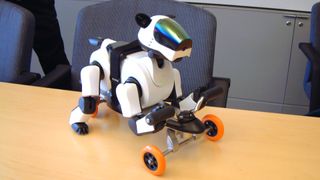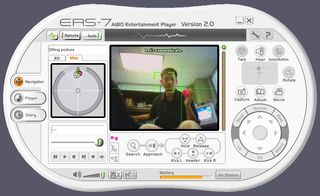I've been testing Sony Aibo for 25 years and it's still my favorite robot
A classic that started it all

Before we were obsessed with AI, the world was mesmerized by Aibo, a robotic dog whose name was short for "artificial intelligence robot" and also had the same pronunciation in Japanese as the word "friend".
Aibo was doing AI before it was cool, and it was a sophisticated consumer robot dog long before SPOT was a gleam in Boston Dynamics' eyes. My history with the pint-size bot goes way back.

I've tested or tried virtually every Sony Aibo robot since its introduction 25 years ago. Somehow, I never owned one, perhaps because much in the way I'm allergic to real dogs, I'm allergic to the price of this mechanical one. Ignoring the robot pup's early and continuing innovation is impossible, even as Sony sometimes denied it.
On May 11, 1999, it wasn’t clear Sony had any intention of broad commercial availability. The company produced roughly 5,000 Sony Aibo robots, selling just 2,000 in the US for approximately $3,000 each. They were rare but also a bit of a status symbol, especially after one appeared in Janet Jackson's 2000 hit It Doesn't Really Matter.
Hello, little friend
Soon after that first run, though, Sony execs arrived in my office (I was then at PCMag) with the official First Generation Model, the ESR-111. Larger and dare I say cuter than the original Aibo, the ERS-111 was also more adept. Once again a trendsetter, Aibo rode a scooter across my conference room desk.
Sony often adamantly claimed that Aibo was not a robot dog, even though the ERS-111 had far more dog-like features: its snout was a bit more rounded, the ears stood up and it had replaced the almost antenna-like tail of the original with something that might look at home on a terrier.

The missteps
It wasn't just Aibo's looks. From its earliest iterations, Aibo's sophisticated motors produced lifelike movement and the robot had enough autonomy to seem alive. There was a camera in the snout and some simple processing that let it do things like respond to voices, touch, and carry out canned routines like riding a scooter. I do recall Aibo scooting itself right off the table. A side panel popped off but it was otherwise fine.
Get the best Black Friday deals direct to your inbox, plus news, reviews, and more.
Sign up to be the first to know about unmissable Black Friday deals on top tech, plus get all your favorite TechRadar content.
Sony could never make Aibo more affordable because it stubbornly refused to skimp on the components or intelligence. The electronics giant tried to satisfy the more affordable Aibo urge with a pair of $800 and far less compelling bear-like bots, one was called Macaroon and the other Latte. They did not catch on.

In 2001, Sony made a brief detour with Aibo. The ERS-220 turned it into a terrifying cross between the original pup and Robocop's ED 209. Honestly, the less said about this misfire, the better.
Yes, it's a dog robot
Sony returned to my offices in 2003 with a completely redesigned model, the ERS-7. Gone were most of the original Aibo's sharp edges, as Sony finally embraced the "dog" label. It had floppy ears and a smooth Snoopy (circa 1970s) face. It could yap at you, follow you around, find its own charger, cuddle in your lap, and perform tricks based on the cards you showed it.

Sony also designed the ERS-7 to be a sort of watchdog and mobile entertainment system. I took my review unit home, tried to play MP3 music through its tiny speakers, and let it take videos and photos (416- by 320-pixel resolution!) that it could email to me (when it worked) or store on its internal Sony Memory Stick that I could remove and look at later, assuming I had a Sony Vaio PC with a Memory Stick reader 🤦♂️. Its AI allowed it to learn and change over time. Don’t get me wrong, this was no ChatGPT puppy but the ERS-7 was still impressive for its time.
Battery life was never great on the Aibo and I vividly remember returning home one day to find it sprawled out and lifeless on the kitchen floor. Aibo had once again failed to find its charge base. I also recall us all being visibly upset at the discovery. We'd become attached to the little robot and couldn't bear to see it in distress.

Return of the dog king
The ERS-7 still listed for almost $2,000 and so it failed to catch on in the US. By 2006, Sony had discontinued Aibo.
More than a decade later Sony revived Aibo as a redesigned and unmistakable puppy. With the adorability, features, and technology (new actuators, WiFI, SLAM, a mobile app) cranked to 11, ERS-1000 cost almost $3,000. Still, when I finally brought a test unit home, it felt like it was worth every dime.
The new Aibo could learn 100 different faces and, like a real dog, remember its interactions with individuals. Its movements were nothing but cute and I still remember how my wife – who initially expressed disinterest in the new Aibo – ended up many evenings sitting with it in her lap, as she absentmindedly stroked its plastic back and head.

25 years on, is Sony Aibo still a thing? Hard to say. Aside from this year's Limited Edition Espresso Aibo, which added different colored eyes and three years of AI cloud updates, there hasn't been a major update or redesign since 2018. Worse yet, Sony appears to be treating the robot dog as a sort of clearance sale, reminding buyers, " Aibo is sold as FINAL SALE – NO RETURN".
The most recent firmware update was a few months ago, but the release notes make no mention of richer AI or even dipping a paw into Large Language Models (LLMs) and Generative AI. Still, I like to imagine how access to ChatGPT, Gemini, and other LLMs might transform Aibo. Such a move could reduce Sony's development costs and open the door to an updated and cheaper model. They could call it Aibo AI if it weren't redundant.
Regardless, my affection for Aibo in virtually all of its iterations remains strong and I may someday save up to buy this iconic robot pup – assuming it's still around.
You might also like

A 38-year industry veteran and award-winning journalist, Lance has covered technology since PCs were the size of suitcases and “on line” meant “waiting.” He’s a former Lifewire Editor-in-Chief, Mashable Editor-in-Chief, and, before that, Editor in Chief of PCMag.com and Senior Vice President of Content for Ziff Davis, Inc. He also wrote a popular, weekly tech column for Medium called The Upgrade.
Lance Ulanoff makes frequent appearances on national, international, and local news programs including Live with Kelly and Mark, the Today Show, Good Morning America, CNBC, CNN, and the BBC.